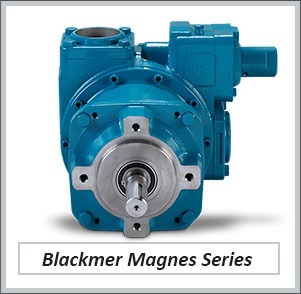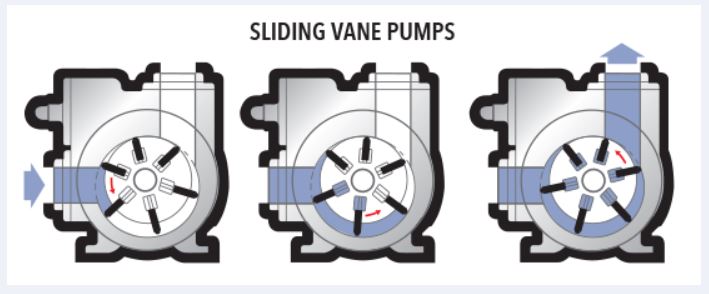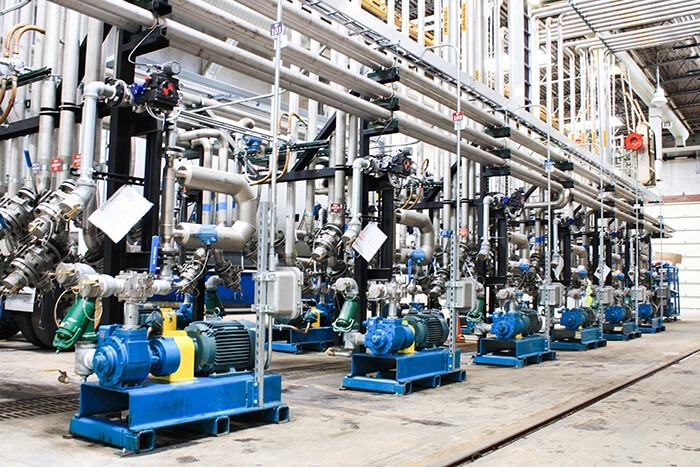Choosing the right positive displacement pump can be a challenging endeavor. A rotary vane pump maybe the right choice depending on the application, media and environmental circumstances. What are rotary vane pumps and how do they work? Check out the article below on the ins and outs of rotary vane pumps.
What is a Rotary Vane Pump?

A rotary vane or sliding vane pump is a type of positive displacement pump that works on rotary positive displacement principals. Sliding vanes on an eccentrically mounted rotor extend and trap liquid in a crescent shaped pump cavity creating liquid chambers. The sliding vanes keep a close seal against the inner cylindrical housing wall to keep the fluid moving and to prevent the fluid from leaking in the opposite direction. The vanes transport the fluid through the system until it’s expelled from the pump discharge. Rotary vane pumps work best for transporting thin or medium viscous liquids at low pressures. The components are usually made from ductile iron or stainless steel that are geared towards wear resistance and fluid compatibility.
Photo Credit to: Blackmer Pumps
How Does a Rotary Vane Pump Work?

A rotary vane pump has a rotor that is mounted eccentrically inside a cylindrical housing. The mounted rotor is nearly touching the top of the cylinder, which creates a crescent shaped cavity in the housing. Sliding vanes mounted inside the rotor move in an out primarily due to centrifugal forces as the rotor rotates. Vane contact with the inside of the cylinder housing occurs because of centrifugal forces, push rods moving between opposing pairs of vanes and liquid pressure entering through the vane grooves and pushing on the rear of the blades. In a typical fluid cycle, the volume of liquid between adjacent vanes changes due to the eccentrically mounted rotor. The open inlet side creates suction and draws fluid in and the sliding blades extend to seal in the liquid, creating liquid chambers. The fluid becomes compressed, the vanes are forced back into their slots and the fluid is discharged when it reaches the outlet side. The vanes are often constructed of carbon graphite to minimize wear when fluids have less lubricative properties. Some rotary vane pumps contain a thin film of oil on the inner cylindrical housing walls that acts as a lubricant, allowing the rotor to rotate with the vanes touching the cylindrical walls unimpeded and it is also used as a sealant. The oil helps trap the liquid between two blades as the rotor rotates.
What are the Benefits of a Rotary Vane Pump?
There are several benefits of rotary vane pumps. They are excellent at self-priming and often have extended dry run capability, eliminating the need for expensive priming and monitoring systems. They can be low maintenance and economical units. Over time, the vanes on a rotary sliding vane pump will wear, likely faster than other parts. However, the vanes can be easily replaced resulting in little down time and cost savings. Also, many rotary vane pumps can be direct driven or belt driven and do not always require gearboxes to reduce operating speeds. That means no gears or transmissions that will need replacement. Rotary vane pumps are remarkably efficient requiring less horsepower than other pumps, which means a less expensive motor and reduced electricity use. Rotary vane pumps are reversible, which make them a terrific resource for loading or unloading vessels and ensuring liquid is recovered from delivery hoses or piping. They are also capable of pumping fluids with solids, albeit with slow pumping internal velocities.
What are the Disadvantages of a Rotary Vane Pump?
The efficiency of rotary vane pumps often decrease when processing high viscous liquids. Rotary vane pumps struggle with high viscosity liquids because they prevent the sliding vanes from going in out with ease. However, high viscous liquids can be pumped with rotary vane pumps, by using heating jackets to promote pumpability. Another chief disadvantage of a rotary vane pump is the inability to pump abrasive materials. Abrasive materials can damage the the sliding vanes causing them to wear faster and can also damage the inner cylinder. Rotary vane pumps don’t perform well in high pressure applications. If the pressure starts to increase the sliding vanes may have trouble maintaining contact with the casing walls, which means it will have trouble moving fluid from one side to the other and possible leakage can occur.
What are Common Applications for Rotary Vane Pumps?

Pictured: Blackmer sliding vane pumps in a chemical processing facility
Photo Credit: Blackmer Pumps
Rotary vane pumps are a terrific, efficient option for transferring clean, low to medium viscosity fluids and fuels for a wide range of temperatures and low pressures. They are a solid option for the following applications:
• Fuel and light oil transfer
• Lubrication
• Gasoline/Petroleum
• LPG/Propane
• Chemical Handling
• Alcohols and Solvents
• Bitumen Transfer
• High Temperature Fluids
• Liquified Gasses
• Aerosol and Propellants
• Paints, Inks and Coatings
To summarize, a rotary vane pump is a positive displacement pump that is a great choice for pumping low to medium viscous media for low-pressure applications. It works using an eccentrically mounted rotor with sliding vanes that create fluid chambers, which transport the liquid around a crescent shaped cavity until compressed and expelled through the outlet port. The pump is relatively low maintenance, excellent at self-priming and has dry run capability. A rotary vane pump is not the best choice for high pressure applications and moving abrasive and/or high viscous media.
